Chapter 28. The Search for Extraterrestrial Life
28.1 Introduction
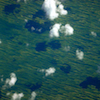
Author: Scott Miller, Pennsylvania State University
Editor: Grace L. Deming, University of Maryland

The goals of this module: After completing this exercise, you should be able to:
- List the three key requirements for life as we know it.
- Describe the evidence we have in support of the theory that liquid water exists beneath the surfaces of several of Jupiter's moons.
- Describe why we believe Mars' climate was warmer and wetter in the past.
- Recognize how the type of star affects the habitable zone around it.
In this module you will explore:
- The requirements needed for "life as we know it" to exist extra-terrestrially.
- The evidence we have in support of the development of life on Mars billions of years ago.
- How the temperature of the central star determines the locations of the planets on which life is more likely to develop.
Why you are doing it: The search for extraterrestrial life attempts to answer mankind’s basic need to know if we are indeed alone in the universe. This is one of the most fundamental, most basic questions ever asked by sentient beings and is proving to be one of the most difficult to answer. Knowing how we can narrow our search is indispensable to making the task doable. Studying the criteria we use in that search also helps us learn something about the beginnings and evolution of our own species.
28.2 Background
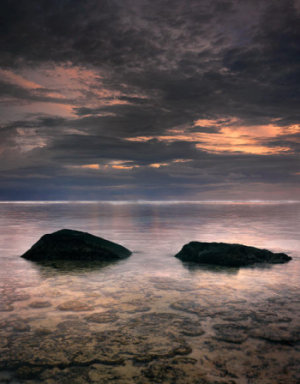
In order to search for evidence of extraterrestrial life, we need to first understand life on Earth and what life needs in order to thrive. This will help us know what to look for when we turn our search outward, and it will also help us to recognize signs of life in unfamiliar settings.
Life as we know it depends on three main things:
First, life on Earth requires liquid water. All living things require some liquid water to survive. In addition, most scientists believe that the reactions that first formed organic compounds occurred in liquid water, in other words, that life evolved from the sea.
Second, life on Earth is carbon based. All living things on Earth are composed on a basic level of carbon compounds, known as organic molecules. Why is this so? Carbon has several properties that make it a good building block for the development of life. Carbon is an element that bonds easily with a wide variety of other elements, and the bonds it forms are strong. This means that carbon can form many different kinds of molecules, allowing for significant diversity among living things. The molecules it forms are stable and do not easily break apart, which allow large, complex compounds to form and endure.
Third, life requires an energy source (a source of heat). The reactions that are believed to have initiated life on Earth are endothermic, meaning that they require energy to occur.
As we search first the Solar System and then the universe for extraterrestrial life, it makes sense to begin looking where life is most likely to be found. Liquid water seems to be the rarest of the three essential conditions listed above, so the natural first step is to focus on this requirement. Once we know where these places are, we can examine each for its potential to meet the other two criteria.
In our solar system, there are a few possibilities (other than Earth): some of the larger moons of Jupiter and the planet Mars. In this activity, we will examine each of these possibilities in turn.
28.3 The Ocean of Europa

Planetary scientists have long known that Europa, one of Jupiter's large moons, was completely covered in ice. Spectroscopic observations of Europa show absorption lines at the wavelengths expected for water ice, so at least some of the surface of Europa must be covered in water ice.
This evidence was confirmed by images sent back by the Galileo spacecraft between 1995 and 2003. Galileo's findings strongly suggest that the entire surface of Europa is covered with a bright, clean crust some tens of kilometers thick of water ice on top of an ocean of water. The fact that the surface ice is so clean suggests that it has not been exposed to the surface long, but instead is continually brought up to the surface by processes deep inside this moon, much as tectonic processes circulate material inside the Earth. Such "water tectonics" would mean that Europa's interior must be warm.
The moon itself is too small to have retained any of the heat of its formation, but tidal stresses from its proximity to Jupiter could easily provide the energy needed to keep Europa's interior water in a liquid state. Such stresses and internal tectonics could also explain the complex fractures and ridges seen on Europa's surface, as shown in the figure. Is this enough energy to support life? We do not know at present.
In addition to spectral and photographic evidence of water on Europa, Galileo made measurements of its magnetic field. Europa does not create its own field, but as it moves through Jupiter's magnetosphere, Jupiter's strong magnetic field induces currents in Europa's interior. These currents generate a weak but measurable field, which is what Galileo detected. In order for this to happen, there must be an electrically-conducting fluid inside Europa. Pure water does not conduct electricity, but water with dissolved minerals does. If Europa does have a salty ocean, it makes it even more likely to develop life!
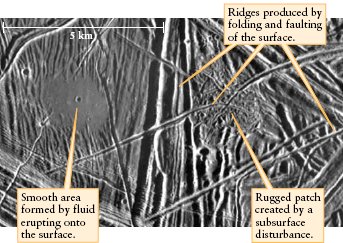
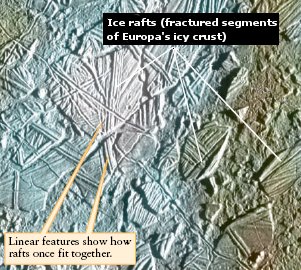
There is similar evidence for the existence of liquid water for two of Jupiter's other moons - Ganymede and Callisto - as well. Callisto has a fluctuating, induced magnetic component like Europa, indicating that it too may have a thin liquid layer somewhere in its interior. Ganymede generates its own magnetic field, which implies that its interior is warm enough to have a liquid layer. This figure summarizes what magnetic field measurements suggest about the interiors of these moons.
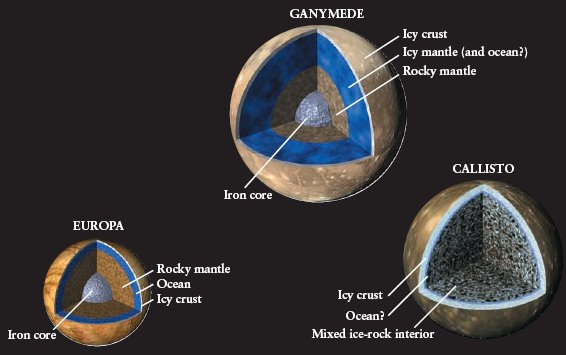
Does this mean that life is (or may in the future) evolve on these moons? No one can answer this definitively, but it is possible that single-celled organisms may have evolved, and may even be thriving, deep inside their interiors. Future study by spacecraft is needed to shed more light on this intriguing possibility.
Question Sequence
Question 28.1
WqGc052KFZU919H8Fnjp2yC0/MnoGXELWVULqOaKcEpmVGsMA5tDZvBa9bDMuL6PN+735hWitbcTL47lsAlvy5sHGjpvg48p764XTH8gODuDhm3uUmcGdbwhtxtV866nRwhtzP8qAtkGku4+d9JPYcZKRUW6xV2qNNHZMDSNDrvuoZdMKOHLJDx3C5HNRRTFmLfCOiIM4ZUlNn1blyoYNP33atGwWAcuNSOeV2V1MfuAMQS3IW/dFM6DQ1XRpnt3eDw1snksbljd8TmVGzwc8obJzjnN6zf7EgxuyxIawqDjmzi1LlDgkI82upR6l8qttDiwaVWIa75xV2PlH33g6Z6GaIci3FWmgAQ0dmUD7Z/qvzhox8IxRo3jhw1Zy0lKfHuDstkrquM4b6sIAE7sPOvr674kW49/1Cc3rpZkI9UY7XwVS7CpkgrPQCkF2JPiVN/WGax04vrt0sQ/TKDk+FvjYwsafCQkF0M4FMmT7frPg13yyIOOYucB8PRiIbqNCcD9D2xQkb128JzBgtTexUVi84sSzWLwnAtb32L3At/a1/BioiQlMi+kNco4fNWZcUrRC38s/i/03wACMNMtN3hS/XtsTmBZoisLuijYAu2KdJRitwUKrLJw33vV1ON3m7Awn5N7KpmOhVFO5WjuiwYgwC54z4Jta5rxGf/iTjR9g7WVNrj10SzTj/2PlqW4B2YpJ3x62hzbpelhEVHHMBkhTdvdopJC1rvIQ06ZiLZ3jveLSr162V/t7QY9T/O7hkYIY/7NCsSOrRM072yubDT5E+fiAZVwqcQD7aojcXg3rHxLmQwHgRa7r/xmW66wj9CYJwO4uWs=Question 28.2
UYhXA3WyGAX4J70JMhZRdEte/F8gku5pfWORinv9+MGnOA8Ek/jP/zYfQ1YxC/X6PRtwo9ZqlZ+32WL0JrgboXUlV9HOGLOQ1QcW7mR8c0OrgYUMcdl+6wmSAiTQt7g9m95MRBAJMmMlBVOdT+QAfYV3s2eKw015lw3W0O3XZtdB9QCeY/VioX96mkLrZZXAEjj2ywicmvW9dQIMrQ7YIzefvNvqV7cypRp8wBqejkmqzS6UTWceY6hIQo7MLErIAB41TcR2lobtjiEjGeXlC4QwGYmKL05bRdLFiOGr/QwKfO41aS8meRWSgVLck44xbx8saFUypF/wrr2beoQoGOBQF3Fia4JD8+8t2t6LhrcaC2H4k4ULhW/s4AavbbRZDQC46EbiM48WKvTUw5CUg+NDJJ+JpLeDjr0/ohHwcnY2X2g+CmWfJ7xWnNGBMAJhrU43mDqWdtZ2iSOzjKJzYT6Xgh16MUhTeE8tTbv0L1xXB++/2YmfwBoG/JR6vXNUN7N3qd6+Eg/e3+KBn2lRhZs1dRWKTqaCqQVl+SKeADm2R08XazZMzRoCnQRIIZm0ljrIFZplgd0ufWpt+8lfIVRYchyeSUCxoz3D49IAvdA6yt+YnNQPqd92Cgk5al0wpa6nPe0Ijr/gEiUZN8etMTtyb8HtXMgnVePwmhfGOeI4WUOkRuKgGulBBbebUOmmWzDOTf5pIfaevimxbZulCXLXMKZ+1eB+fu0XPlObVYs7aTfiH5SyXg==28.4 Water on Mars
It is certain that no liquid water exists on Mars today; its current atmosphere is too thin to hold down liquid water. The intriguing thing about Mars is that we see abundant evidence that liquid water existed in great quantities on Mars' surface in the distant past, before life on Earth evolved past single-cell organisms. Images of Mars reveal that much of its terrain was shaped by running water. The Martian surface shows dried up riverbeds and teardrop shaped islands, for example, that look exactly like those formed by liquid water on Earth.
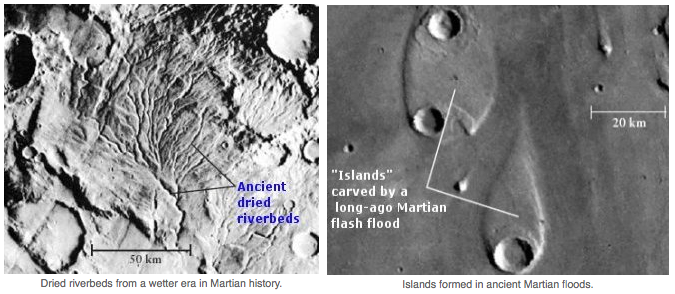
In 1997, The Mars Pathfinder rover Sojourner explored a part of the northern Martian hemisphere that appears to have once been a flood plain. It found a distribution of rocks exactly as would be expected if the rocks were carried and deposited by floodwaters. In addition, some of the rocks were sedimentary, indicating that they had formed gradually at the bottom of Martian lakes or oceans. This is strong evidence that liquid water not only existed in Mars' past, but that it existed for a long period of time.
The Martian explorers also found two types of evidence of liquid water in Mars' past. The first discovery was of grey hematite, a mineral that, on Earth, forms almost exclusively at the bottom of a lake or hot spring. Secondly, in 2004 the rover Opportunity found evidence of jarosite, which also forms only in the presence of liquid water.
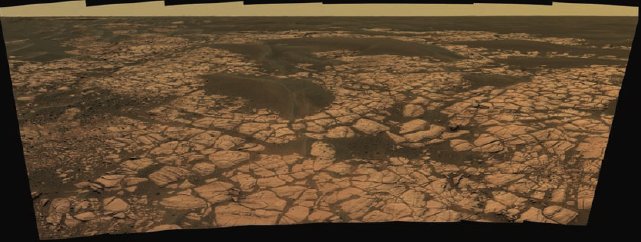
Taken altogether, this evidence strongly suggests that the climate on Mars was much warmer and wetter billions of years ago. What happened to the water on Mars as temperatures dropped? Detailed observations of Mars' surface show large deposits of water frozen beneath its surface. These deposits are concentrated at the poles and equatorial regions. At present, scientists estimate that if all of this ice melted, it would be enough to cover the entire planet up to a depth of 450 meters.
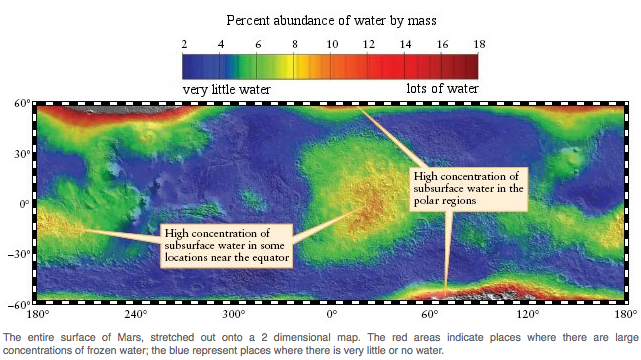
Question 28.3
foeIHskkq7uFWlowf4S2qQlY5mcT6jCX6R4LnSYLyPwBEZrAJHM40FydXTICsdMBP4pdJDh83NVVWDajrCqR1Bbc73/ISdYIITj5V+9tpa9auFzD+dY4d5vmQf+eMYx1DXyMFZS92FYvZgF0CcPUhXHxjwI6zubpeZ8R4vrhR6akgsgLidCTgjak+j27ufLSoYJER6AhxpEuUOsSxNE+Af/1kfxmM1XnLwwGbbIpfjXs5RCA2s8wVcgAZWo=28.5 Life on Mars?

Could life on Mars have once existed and possibly even survived the drastic climate changes the planet has undergone? Even if life did not survive these changes, evidence that it once flourished under better conditions on the planet would lend strong support to the theory that life may easily develop anywhere in the universe where the right conditions are met. That fact, in itself, would be an amazing discovery!
Astronomers use both direct and indirect methods of searching for life on Mars. The most direct method is to actually send a spacecraft to Mars and use it to collect and test samples of Martian soil and rocks. Several rovers have explored areas of the Martian surface in the hope of discovering evidence - past or present - of life. While some did find evidence of the presence of liquid water in Mars' past (as discussed previously), none encountered any definitive evidence of currently living organisms.

An indirect method of searching for life on Mars is the study of a certain type of meteorite found on Earth. These 'SNC meteorites' differ from other meteorites because the gases trapped inside them differ significantly from that found in Earth's atmosphere. The trapped gas does, however, match Mars' atmosphere almost perfectly! This strongly suggests that SNC meteorites originated on Mars. One such SNC meteorite, ALH 84001, was found to be about 4.5 billion years old - just the age when liquid water existed on Mars. It also had rounded carbonate grains that form exclusively in liquid water, supporting the theory that this meteorite formed during the time when there was liquid water on Mars.
The carbonate grains in ALH 84001 had three more unusual features directly indicative of the presence of life. First, scientists identified small tube-like mineral structures (fossils?), similar to primitive microorganisms found on Earth. Second, they found compounds of iron sulfide and magnetite in the meteorite; on Earth, bacteria produce these compounds. Third, they found organic molecules in the carbonates; these organic molecules are normally produced by the decay of microorganisms. Taken together, these three findings suggest that life may have existed on Mars during the period when liquid water was also present there.
The findings of these scientists strongly suggest life, but are also highly controversial. Many scientists point out that other processes not involving living organisms could have produced the structure and compounds found in the meteorite. Until more evidence from this era is found and studied, we cannot be sure.
Question 28.4
mSSsaPR2WjxqZKXdko/tBlZWiZEIemTskO0Til1ykHl/oNQTIXPcJ5+4pNMl9MP450U4Nq8//URcW15j0auiGctuOVgfluCLoq5+Il5Fhm+TTDTM1at1U+SvjPs7IHKp68kVmY38bxvZs4C7TKdPo+DLb4LIAMWSOetjwuxX5CHziUkn6Y9f4EoPhqEpSIpycjRDwQufYyCgci4J5LAWQo15YNCkB7IarJbSYtuQR/J8EB3C3rIRunZzy7ceIxE+KgPpNBUEoE+JvsLpdRtVwhBmnFyAS8lxg+vt1E5K5kAorLDTL97SlwgksgCPKnpMLkBkrHgH0WiTZ7Zpok0exep5YiOAKMeT9bo3NhFajSSGBwJIcFEvh+SweAki0YVDvWyzbXV+77BFy0ITKCKU0jqmXbeHKBIL4SvkkwaIJfxd8sgcP5at7u1d2KjTU5HNkOC9fsAlvVXYukjV5/bgnwf/u+EYaGX7nP3b1w4OOs/XI5IZL0bdpmPLl/8Pa3gM28v2ac8nxNy3xp7ZcWYPKMFpz2xrCMZOi+98PVmW2yirRWYwcKAlYTzuwVYxyKgmTO4L2Ehv7pT63EjMTS5EUjGSAABwszzW3DOr6GcZ0vFz3f4HRjKOIiBITODv/6o/P64Jjfkl2J+oN+O5c3EcMD28fbhczZWlZzD2LzcdfmXGrgvrYzFDI+wmsxuKqCWQuuD/HFqv2I5V4Q3JcwwYGNcUJEqjObJlRiZg3oDJiaBeYfzAm3V7H1iojh7ly6ZVyzcvvRYqARQgwuwBGGacJXtl56KYsV+Jc0ygCL6kwyOW7DlvHivO6xJq5p1euGJMOOWcocbgrCF2LHGItV1yqgNUVfArtvzVqqp6t5whCe7rSGTeem3dAKMKXFp3FgOeZfscdnHlyACcRUXwJLmfrCKWntzx5rvSJI864ZInhzXRM2Nqs/5vwCGu2gSSGYeURgttu2u/Fu3cKxezVQT7yJt+Gq7O9CI6BIn3Ng15zlQ=28.6 Beyond the Solar System
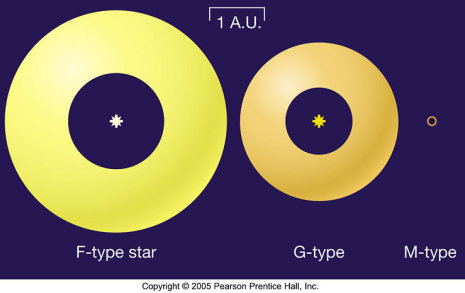
So far in this activity, we have concentrated on locations in our own Solar System where we know (or suspect) liquid water exists or once existed. But what if we turned our search outward to the stars? How would we know where to look for places where liquid water might exist? Is it possible to narrow our search?
We can limit our search to only those planets whose surface temperatures allow water to remain a liquid. Although it is possible that life can develop on planets or moons that are icy (we have already discussed the possibility of life developing inside some of Jupiter's moons), we can't easily find such life simply because we can't see it. A planet's surface temperature depends mainly on two factors: the amount of energy it receives from the star it orbits and the amount and type of atmosphere it has. It turns out that the first factor provides a useful way of limiting our search for extra-solar planets that may have liquid water.
The amount of energy a planet receives from its central star depends on both the planet's distance from the star and the star's temperature. The spectral class of a star is designated by letter (OBAFGKM), which corresponds to its temperature, O being the hottest and M the coolest. These factors can be combined to form the concept of a habitable zone, the region surrounding a star where the surface temperature of a terrestrial planet would allow water to exist in liquid form (if, of course, the planet had enough atmosphere to push liquids down.). The habitable zone for any given star is a ring-like region with an inner radius defined by the distance at which water would boil away and an outer radius defined by the distance at which any water would freeze. The area between these two radii is the region where a planet receives enough energy to keep water on its surface from becoming ice, but not so much energy that its water evaporates into gas. Select a temperature class of the star in the animation below to see how temperature affects the size and location of the habitable zone. (Our Sun is a G-type star.)

Question 28.5
e7aVVp+0wcSHcmWVylGbXc+ZDzv7nT+2DB1IuoWVYlcHXpz/Rx1pbwiZzvFmVcAUb9e85tkt0tos4bnrg3ewOV19e1qlNZxM8e+0Y9G6GaP9BSpH0OmJaQ9vkzViQB6gFxZCG8/4GvyPoX0b/Yaapw==28.7 Earth, Our Liquid Water Planet
In this activity, you have seen that we do know a little - and don't know a lot! - about the possibility of extraterrestrial life. We know of a few places in our own solar system - some of the moons of Jupiter (most notably Europa) and Mars - where life could exist. However, the evidence as to whether life actually did develop (i.e., the meteoritic evidence of past life on Mars) is at best suggestive, not definitive. Right now, we simply do not know if life has ever existed, or will ever exist, other than on Earth.

As we look beyond the Solar System, that uncertainty grows. We find that even if we limit our search as much as possible, there are still millions of stars that must be carefully observed to determine if they harbor planets capable of supporting life. Clearly, much remains to be done before we will know with certainty if life existed, or possibly even still exists, elsewhere in our solar system and in the universe as a whole.

28.8 Quick Check Quiz
Indepth Activity: The Search for Extraterrestrial Life